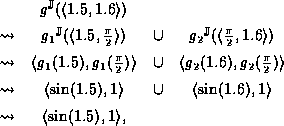




Next: 3.2.16 Partial Functions
Up: 3.2 Constant Interval Arithmetic
Previous: 3.2.14 Examples with Piecewise Monotonic
Consider the piecewise monotonic function  .
With thin arguments, the evaluation of
.
With thin arguments, the evaluation of  proceeds as follows:
proceeds as follows:
with
With thick arguments, the evaluation of  is displeasing:
with
Although the result returned is optimal, the amount of work performed
to determine the result may be reduced.
is displeasing:
with
Although the result returned is optimal, the amount of work performed
to determine the result may be reduced.
We will cut the function  into sections where
each section attains the extreme values of g:
into sections where
each section attains the extreme values of g:
where
When evaluating  , we may simply return
, we may simply return  if any of the aforementioned sections lie within j:
As with the previous sectioning scheme, there will often be a
preferred sectioning, denoted by
if any of the aforementioned sections lie within j:
As with the previous sectioning scheme, there will often be a
preferred sectioning, denoted by  , which we
will use to check containment.
, which we
will use to check containment.
With our example function g,  ,
,
so the previous evaluation may be shortened.
It may now proceed as follows:
with
This rejection test may be performed with a single subtraction,
to find the width of the argument.
Another quick rejection test is possible, by allowing
another class of intervals into  :
:





Next: 3.2.16 Partial Functions
Up: 3.2 Constant Interval Arithmetic
Previous: 3.2.14 Examples with Piecewise Monotonic
![]() .
With thin arguments, the evaluation of
.
With thin arguments, the evaluation of ![]() proceeds as follows:
proceeds as follows:

![]()

![]()
![]() into sections where
each section attains the extreme values of g:
into sections where
each section attains the extreme values of g:
![]()
![]()
![]()
![]()
![]() ,
,
![]()

![]()
![]()